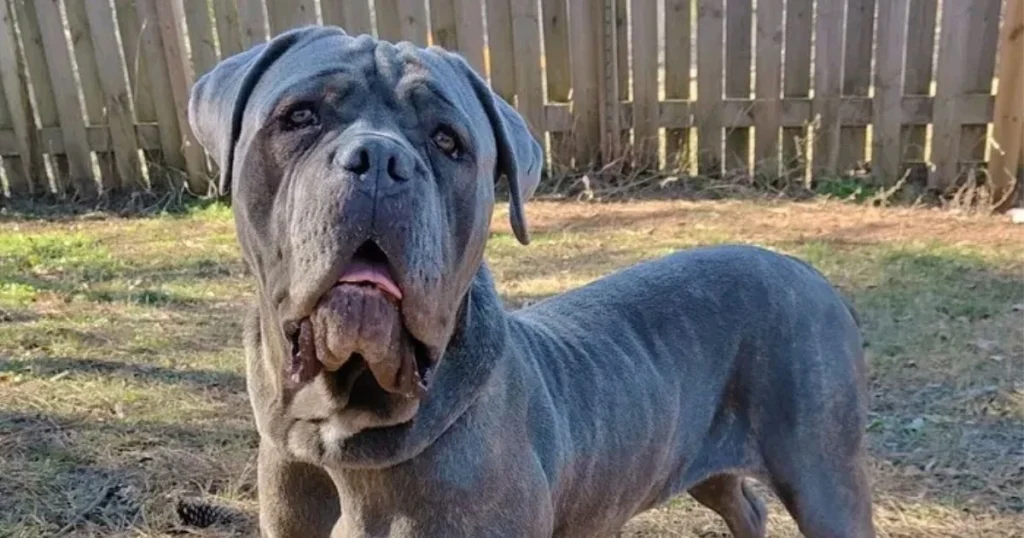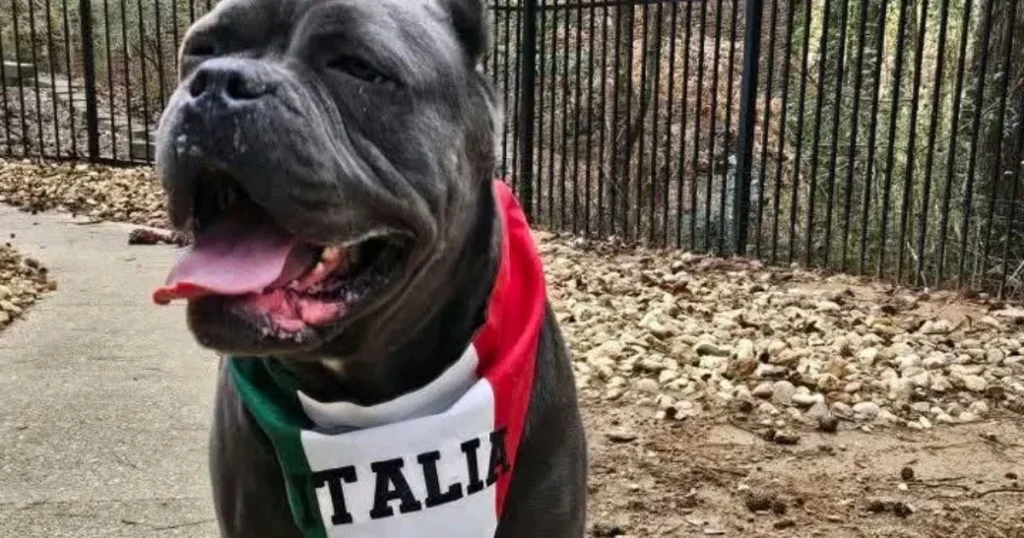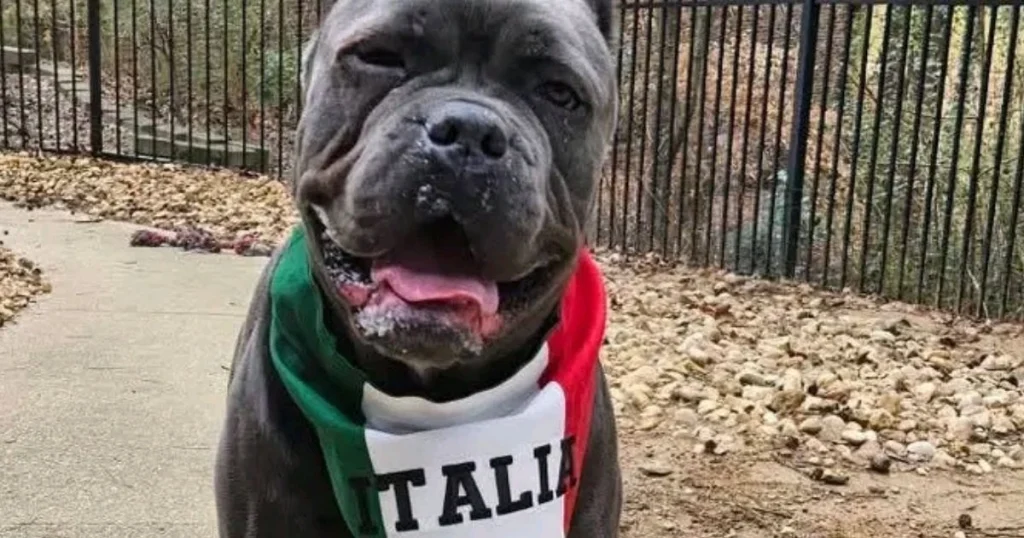Blue Cane Corso Italiano: Unique Traits and Characteristics of This Rare Coat Color
Table of Contents
Blue Cane Corso Italiano
The Blue Cane Corso Italiano stands out with its rare blue coat. This dog has a rich Italian heritage and a unique look. It’s known for its strength, loyalty, and special color, making it a popular choice for those who know what it needs.
Key Takeaways
- Blue coat genetics create a striking visual marker in the King Corso breed.
- Historical roots trace back to Italy’s working dog traditions.
- Rare coat color requires specialized care to maintain health and vibrancy.
- Temperament balances protective instincts with family-friendly traits.
- Owners must prioritize breed-specific health monitoring and socialization.
History and Background
The Blue Cane Corso Italiano has a long history, dating back thousands of years. It combines ancient uses with today’s admiration. Its roots come from mastiff ancestors, like the king corso mastiff full grown, which gave it strength and versatility.

Early Origins and Lineage
This breed comes from Italy’s past, where it was used as Roman war dogs. Mastiff ancestry is seen in their strong build. Mixing with the king corso mastiff full grown made them more resilient and loyal.[ More ]
By the Middle Ages, these dogs were key on farms. They helped with livestock and guarded estates.
- Origins: Ancient Roman war and guard dogs
- Influence: Mastiff and king corso mastiff full grown bloodlines
- Purpose: Farm work and protection in medieval Italy
Evolution of the Breed Over Time
| Time Period | Role | Key Changes |
|---|---|---|
| Ancient Italy | War and guard duty | Selection for aggression and endurance |
| 19th-20th Century | Farm work | Decline due to industrialization |
| Modern Era | Companion and guardian | Breed standardization; rise in popularity |
In the 20th century, the king corso mastiff full grown’s traits helped revive the breed after World War II. Today, breeders focus on keeping its historic traits while meeting modern standards. This journey shows why the Blue Cane Corso Italiano is both ancient and modern.
Physical Characteristics and Unique Traits
The Blue Cane Corso Italiano has traits that make it special among dog breed concorso types. These features show its history as a working and guardian dog. They also help it fit well into family life.
Distinctive Coat Colors and Markings
The breed’s coat color is its most eye-catching feature. The dog breed concorso is known for its steel-blue base, sometimes with brindle undertones. It also has small white patches on the chest or toes, never more than three inches.[ More]
These patterns are passed down and make their look even more interesting.
- Blue-gray coat with possible silver undertones
- Brindle stripes overlapping the base color
- White markings limited to specific areas
Build, Size, and Structure
They are powerful yet agile, with a build that balances strength and mobility. Males and females have different sizes:
| Gender | Weight | Height |
|---|---|---|
| Male | 80–100 lbs | 24–27 inches |
| Female | 70–90 lbs | 22–25 inches |
They have lean muscle and a broad head, showing their protective side. Their structure lets them do everything from herding to relaxing at home.
Understanding the Blue Cane Corso Italiano
Choosing a Blue Cane Corso Italiano means embracing a breed with a distinct identity. This dog combines strength with elegance, standing out due to its rare blue coat. Unlike the mastiff concorso dog, which prioritizes bulk, the Blue Cane Corso balances muscular build with agility. Let’s break down what truly defines this breed:
- Genetic uniqueness: The blue coat arises from specific recessive genes, making each puppy a genetic marvel.
- Temperament: Protective yet loyal, they form strong bonds with their families while remaining wary of strangers.
- Historical context: Rooted in Italy’s working-dog traditions, their heritage is tied to livestock herding and property guardianship.
| Feature | Blue Cane Corso Italiano | Mastiff Concorso Dog |
|---|---|---|
| Primary Role | Guardian and companion | Guardian and show competitor |
| Average Weight | 60–80 lbs | 100–150 lbs |
| Coat Type | Short, dense blue coat | Thicker, varied coat colors |
When comparing to the mastiff concorso dog, note the size and role differences. Their shared guardian instinct makes both breeds effective protectors, but the Blue Cane Corso’s agility suits active households. Before adopting, research local breeders specializing in this rare variant to ensure health and lineage authenticity.

Personality and Temperament of This Rare Breed
The Blue Cane Corso Italiano is strong yet loving. They are loyal and smart, making great family guardians. With the right training, they learn to protect without being too aggressive.
Loyalty, Intelligence, and Guarding Instincts
These dogs bond deeply with their families. Their king corso mastiff nature means they are always alert and protective. Early training is key for their adult behavior. Key traits include:
- Watchfulness: Always aware of surroundings.
- Trainable: Quick to learn commands and boundaries.
- Confident: Naturally assertive but responsive to calm leadership.
Social Behavior and Interaction with You and Your Family
They love being part of an active family. Early socialization for king corso puppy helps them get along with kids and other pets. Their temperament is:
“A well-socialized king corso puppy grows into a loyal companion, not just a guard.” – Certified Dog Behaviorist, National Canine Association
They enjoy family activities but need consistent guidance. They need daily interaction to stay happy. Raised with kids, they become gentle protectors. But, they need to be introduced to strangers slowly.
Caring for Your Blue Cane Corso Italiano
Keeping your Blue Cane Corso Italiano healthy means focusing on their diet, exercise, and grooming. These steps help them stay physically and emotionally well.
Nutrition, Exercise, and Daily Activity
A good diet is key. High-quality protein like chicken or beef should be 50% of their food. Choose brands like Orijen or Blue Buffalo for muscle growth. Feed them 2-3 times a day to avoid obesity.
- Exercise: They need daily walks (30–60 minutes) and playtime. Activities like fetch or agility training are best.
- Mental stimulation: Use puzzle toys or training sessions to keep their mind sharp.
“Regular exercise prevents boredom and destructive behaviors in large breeds like the Blue Cane Corso,” advises Dr. Emily Carter, a canine behaviorist.
Grooming Tips and Health Maintenance
Brush their short coat weekly to cut down on shedding. Bathe them only when necessary, using oatmeal-based shampoos like Earthbath. Check their ears every two weeks and trim their nails monthly.
- Health checks: Take them to the vet annually for heartworm tests and vaccinations (DHPP, rabies).
- Joint care: Use supplements like glucosamine to support their joints as they age.
Spotting hip dysplasia or thyroid problems early is vital. Focus on preventive care to keep them healthy and full of life.
Comparing Blue Cane Corso Italiano to Other Breeds
Exploring different breeds helps you find the best match. The Blue Cane Corso Italiano has unique traits compared to other dogs. Let’s look at how it differs from similar breeds like traditional Concorso dogs and the Mastiff Concorso Dog.
Key Differences Between Blue Cane Corso and Other Concorso Breeds
Coat and Build: The Blue Cane Corso has a steel-blue coat, unlike the darker tones of standard Concorso dogs. Its leaner, muscular build makes it agile for tasks like herding or guarding.
- Coat: Blue hue vs. brown/black in traditional Concorso
- Energy Levels: High drive vs. moderate in other Concorso variants

Contrasting Traits with the Mastiff Concorso Dog
The Blue Cane Corso is smaller but more active than the Mastiff Concorso. While Mastiffs are calm, the Cane Corso is loyal with bursts of energy.
- Size: Mastiff averages 120 lbs; Cane Corso around 80-100 lbs
- Temperament: Cane Corso’s protective nature vs. Mastiff’s laid-back guardian role
“The Blue Cane Corso’s balance of strength and intelligence makes it a top choice for owners seeking a versatile working dog,” says a certified canine behaviorist.
These differences show how the Blue Cane Corso Italiano suits certain lifestyles. Researching these traits helps you choose the right breed for your needs.
Insights on King Corso Mastiff Full Grown
Knowing your King Corso Mastiff as it grows up is important for their health. By adulthood, their traits become clear. This helps you understand how to support their lifestyle and health.
Characteristics of a Mature King Corso
When they grow up, they show certain traits. Adult dogs are usually 24–28 inches tall and weigh 80–120 pounds. They have strong muscles. Their coat might fade a bit, more so in blue dogs.
| Trait | Range | Key Notes |
|---|---|---|
| Height | 24–28 inches | Measured at the shoulder |
| Weight | 80–120 lbs | Varies by sex and genetics |
| Coat Texture | Short, dense | Requires minimal grooming |
Behavioral and Health Insights
As they grow up, they become calmer but stay protective. It’s important to take them to the vet regularly. Here are some care tips:
- Monitor joint health with low-impact exercise
- Adjust diet to prevent obesity
- Yearly thyroid and heart screenings
“A mature King Corso thrives on routine. Consistent exercise and mental stimulation are their foundation.” – Dr. Emily Torres, Canine Behavior Specialist
They become less impulsive and more focused on their family. Make sure to take care of their teeth and skin. Every dog is different, so adjust their care to fit their needs.
Navigating the King Corso Puppy Stage
Raising a King Corso puppy needs patience and structure. Their first year is key for shaping their behavior and health. Start well to create a loyal friend.
Early Development and Socialization
Introduce your puppy to new sounds, people, and places by 12 weeks. Socialization reduces fear and boosts confidence. Teach basic commands like “sit” and “stay” daily. This builds trust.
- Enroll in puppy classes for supervised interactions
- Introduce gentle handling for future vet visits
- Use positive reinforcement with treats and praise
Essentials for a King Corso Puppy
Quality nutrition is essential. Feed a high-protein diet in 3-4 meals daily. Avoid overfeeding to prevent joint strain. Regular vet visits are important for vaccinations and growth tracking.
“A well-socialized puppy grows into a balanced adult. Prioritize early training and health monitoring.” — Dr. Emily Carter, Canine Behavior Specialist
Give safe chew toys for teething. Crate training at night prevents accidents. Balance play with rest to support their growth.
Expert Opinions on Rare Canine Coat Colors
Breeding dogs with rare coat colors, like the Blue Cane Corso Italiano, is a topic of debate. Veterinarians and breeders agree that rare coat color genetics need careful attention. Let’s look at their views on the benefits and challenges.
Benefits and Challenges of a Rare Coat
- Unique appearance: The steel-blue hue of the Blue Cane Corso Italiano is eye-catching in dog shows and as pets.
- Genetic complexity: Breeding for this color requires strict health screenings to avoid genetic problems.
- Market demand: Rare coats might boost adoption interest but need responsible breeding.
What Experts Say About Unique Appearances
“The Blue Cane Corso Italiano’s color is stunning, but owners must prioritize health over looks,” says Dr. Linda Torres, a canine genetics specialist. “Regular vet check-ups are key.”
Breeders stress the importance of ethical practices. The American Kennel Club (AKC) cautions against focusing too much on coat color. Here are insights from industry leaders:
| Expert | Benefit | Challenge |
|---|---|---|
| American Veterinary Medical Association | Eye-catching genetics can drive breed preservation | Risk of unethical breeding for color alone |
| National Breeders Association | Promotes genetic diversity when done responsibly | Higher cost for health-conscious breeders |
Choosing a rare coat color puppy means balancing beauty with long-term care. Always get veterinarian insights and breeders’ advice before making a decision.
Health, Lifespan, and Preventative Care
To keep your Blue Cane Corso Italiano healthy, take proactive steps. Regular vet visits and vaccinations are key to prevent diseases and extend their life.
Regular Health Checks and Vaccinations
Annual vet exams help catch health issues early. Make sure to schedule check-ups to check weight, heart health, and joint condition. Vaccines for rabies, parvovirus, and distemper protect against serious diseases. Also, use flea treatments and heartworm medication to prevent parasites.
Common Ailments and Preventive Measures
Blue Cane Corsos can get hip dysplasia, bloat, or skin allergies. Look out for signs like limping, sudden stomach pain, or too much scratching. To lower these risks:
- Feed smaller, more frequent meals to avoid bloat
- Keep their joints strong with a balanced diet
- Brush their coat weekly to catch skin problems early
Genetic testing before breeding can reduce inherited disease risks. A healthy diet and regular exercise boost their immunity and life span. Acting quickly on symptoms keeps your dog active and joyful for many years.

Training, Socialization, and Lifestyle Considerations
Building a strong bond with your Blue Cane Corso Italiano starts with tailored training and consistent routines. These dogs thrive on clear boundaries and positive reinforcement. This aligns with their innate intelligence and protective nature.
Effective Training Techniques for Blue Cane Corso Italiano
Use these strategies to guide their behavior:
- Positive reinforcement: Reward good behavior with treats or praise to encourage responsiveness.
- Early socialization: Introduce your dog to new people, environments, and animals before 14 weeks of age to reduce anxiety.
- Consistent commands: Use short, firm phrases like “sit” or “stay” to align with their instinct to follow structure.
Daily Routines and Lifestyle Adjustments
Maintain a balanced lifestyle with these practices:
- Exercise: Provide 60–90 minutes of daily walks, play, or mental challenges like puzzle toys.
- Structured schedules: Keep feeding, training, and rest times consistent to reduce stress.
- Safety-focused adjustments: Secure your home with high fences and avoid off-leash areas due to their strong prey drive.
“The Blue Cane Corso’s loyalty deepens when training is patient and routines are predictable.”
Conclusion
The Blue Cane Corso Italiano is a unique dog with a rich history. They have a rare blue coat and a strong build. They need regular grooming and a healthy diet.
They also need early socialization and positive training. This helps them behave well. It’s important to watch out for health issues like joint problems or skin conditions.
If you’re thinking about getting one, do your homework first. They have lots of energy and need a lot of care for their whole life. But, they are very loyal and loving.
Knowing about their history, health, and training needs helps you decide if they’re right for you. Being a responsible owner means a happy and fulfilling life with your Blue Cane Corso Italiano.
FAQ
What is a King Corso?
The King Corso is a big, strong dog breed. It comes from the Italian Mastiff. This breed is loyal and gentle with families.
How big does a King Corso Mastiff get when fully grown?
A grown King Corso Mastiff weighs 90 to 120 pounds. They are 24 to 28 inches tall. Their size makes them great companions and guardians.
What are the unique traits of the King Corso breed?
King Corsos have a broad head and muscular body. They come in many coat colors. They are smart and easy to train, making them good family pets. They also protect well.
How should I care for a King Corso puppy?
To care for a King Corso puppy, feed them well and exercise them often. Start socializing them early. Keep their vaccinations current and train them well.
What are the common health issues associated with the King Corso breed?
King Corsos might get hip dysplasia, heart problems, or obesity. Regular vet visits and a healthy diet can prevent these issues.
How does a King Corso compare to the Mastiff Concorso dog?
Both breeds are strong and protective. But, King Corsos are more agile and easier to train. They also have more energy.
What is involved in training a King Corso?
Training a King Corso needs positive reinforcement and early socialization. They learn commands fast. But, they need firm guidance to obey.
How much exercise does a fully grown King Corso require?
A grown King Corso needs 60 minutes of exercise daily. This includes walks, playtime, and activities. It keeps them healthy and balanced.
What makes the Blue Cane Corso Italiano unique?
The Blue Cane Corso Italiano has a rare coat color. It’s known for its elegance and power. It’s a striking and protective companion.
What are the grooming needs for a King Corso?
Grooming a King Corso means brushing them often to manage shedding. They need occasional baths and nail trims. Keeping their ears and teeth clean is also important.


